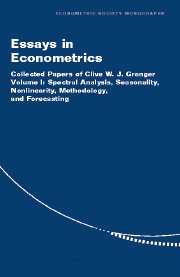Book contents
- Frontmatter
- Contents
- Acknowledgments
- List of Contributors
- Introduction
- 1 The ET Interview: Professor Clive Granger
- PART ONE SPECTRAL ANALYSIS
- PART TWO SEASONALITY
- PART THREE NONLINEARITY
- 6 Non-Linear Time Series Modeling
- 7 Using the Correlation Exponent to Decide Whether an Economic Series is Chaotic
- 8 Testing for Neglected Nonlinearity in Time Series Models: A Comparison of Neural Network Methods and Alternative Tests
- 9 Modeling Nonlinear Relationships Between Extended-Memory Variables
- 10 Semiparametric Estimates of the Relation Between Weather and Electricity Sales
- PART FOUR METHODOLOGY
- PART FIVE FORECASTING
- Index
10 - Semiparametric Estimates of the Relation Between Weather and Electricity Sales
Published online by Cambridge University Press: 06 July 2010
- Frontmatter
- Contents
- Acknowledgments
- List of Contributors
- Introduction
- 1 The ET Interview: Professor Clive Granger
- PART ONE SPECTRAL ANALYSIS
- PART TWO SEASONALITY
- PART THREE NONLINEARITY
- 6 Non-Linear Time Series Modeling
- 7 Using the Correlation Exponent to Decide Whether an Economic Series is Chaotic
- 8 Testing for Neglected Nonlinearity in Time Series Models: A Comparison of Neural Network Methods and Alternative Tests
- 9 Modeling Nonlinear Relationships Between Extended-Memory Variables
- 10 Semiparametric Estimates of the Relation Between Weather and Electricity Sales
- PART FOUR METHODOLOGY
- PART FIVE FORECASTING
- Index
Summary
A nonlinear relationship between electricity sales and temperature is estimated using a semiparametric regression procedure that easily allows linear transformations of the data. This accommodates introduction of covariates, timing adjustments due to the actual billing schedules, and serial correlation. The procedure is an extension of smoothing splines with the smoothness parameter estimated from minimization of the generalized cross-validation criterion introduced by Craven and Wahba (1979). Estimates are presented for residential sales for four electric utilities and are compared with models that represent the weather using only heating and cooling degree days or with piecewise linear splines.
INTRODUCTION
The relationship between temperature and electricity usage is highly nonlinear, because electricity consumption increases at both high and low temperatures. Estimating this relationship, however, is complicated by the need to control for many other factors such as income, price, and overall levels of economic activity and for other seasonal effects such as vacation periods and holidays. A second complicating factor is the form in which the data on sales are collected: Meter readers do not record all households on the same day and for the same period. A third factor is the possibility of unobserved changes in behavior or other causal variables that will introduce serial correlation into the disturbances.
This article introduces a combined parametric and nonparametric regression procedure that easily accommodates linear transformations of the data and therefore provides a convenient framework for analysis of this problem.
- Type
- Chapter
- Information
- Essays in EconometricsCollected Papers of Clive W. J. Granger, pp. 247 - 270Publisher: Cambridge University PressPrint publication year: 2001
- 1
- Cited by



